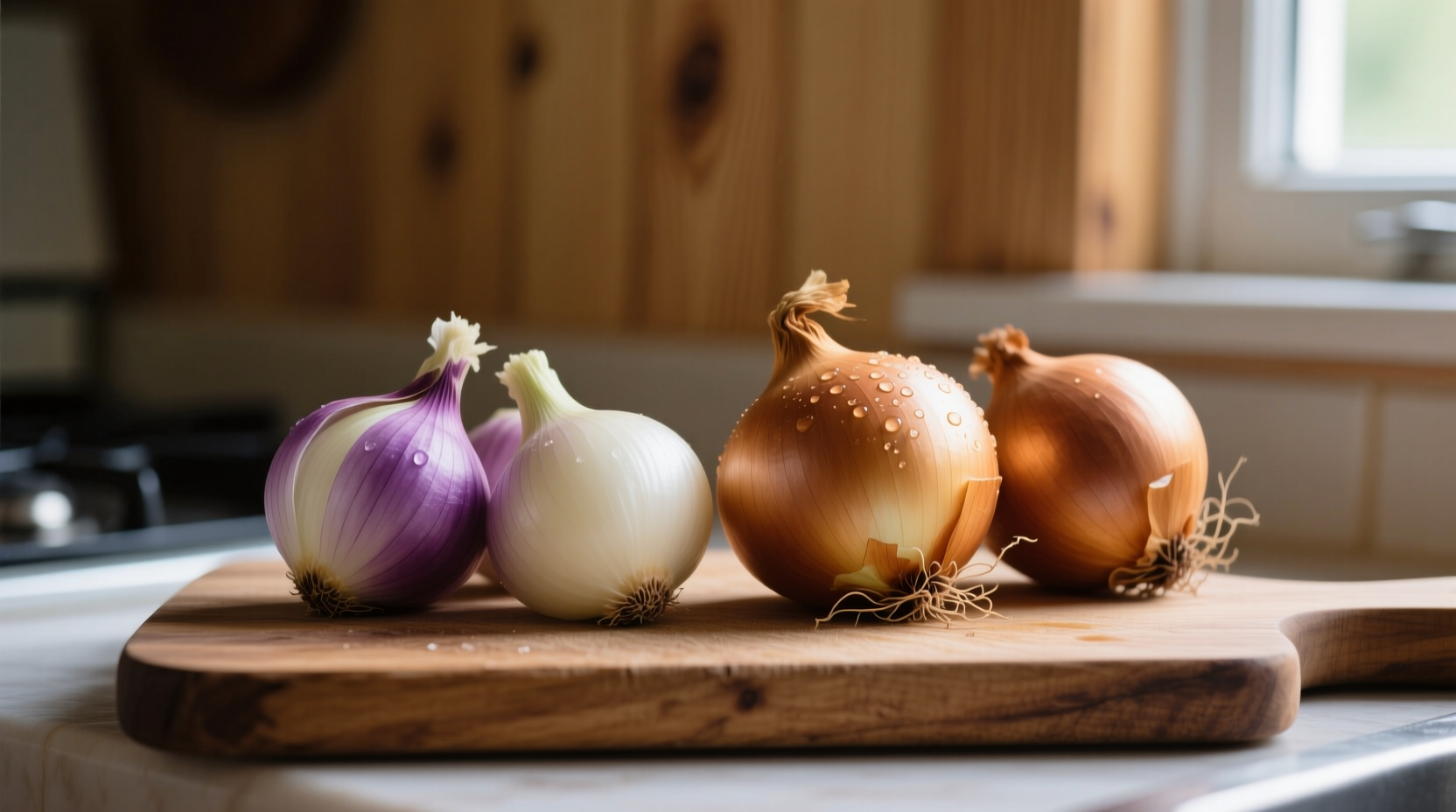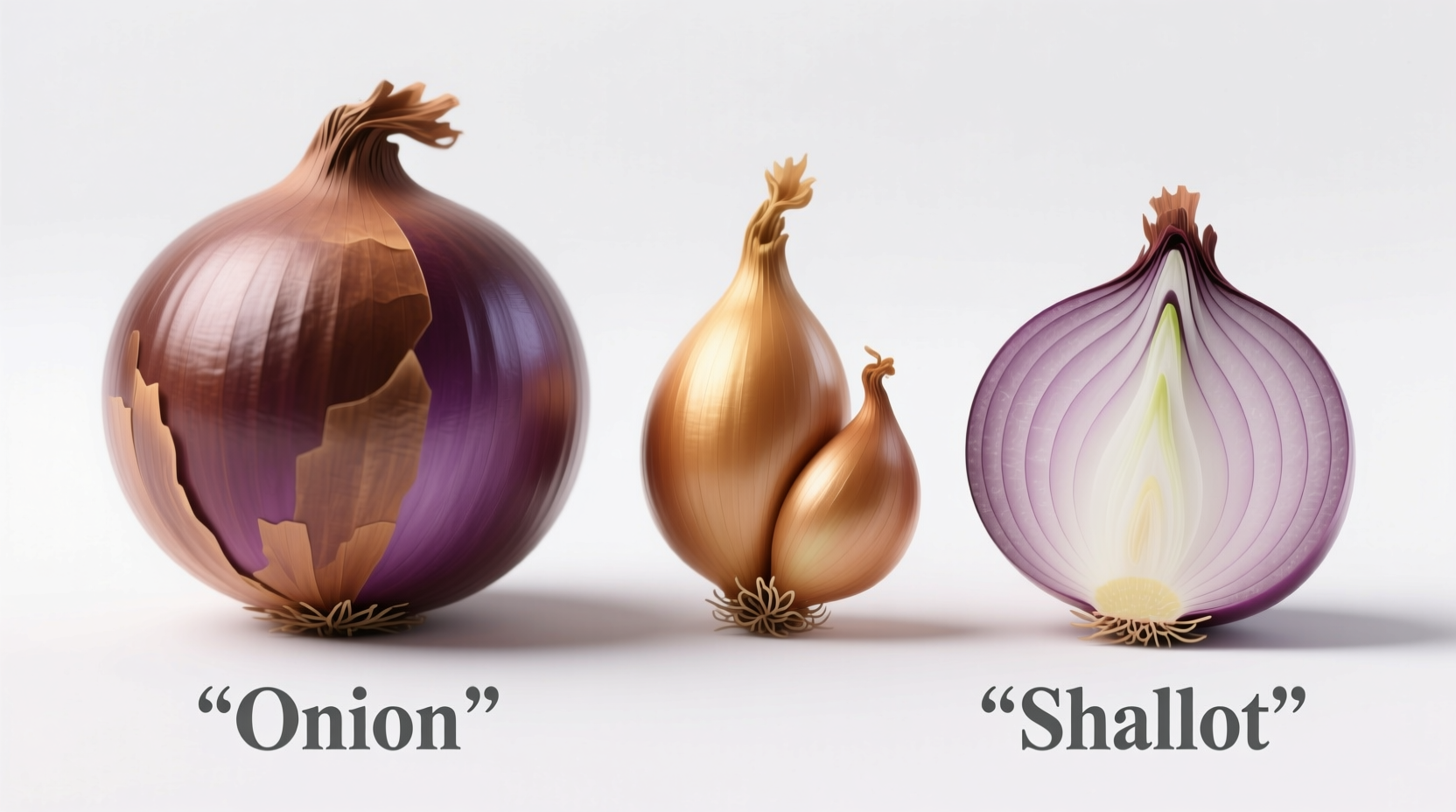Ever reached for an onion in your pantry only to find shallots instead? Or wondered why a recipe specifically calls for shallots rather than onions? Understanding the difference between onion and shallot is crucial for elevating your cooking from good to exceptional. This guide cuts through the confusion with practical insights you can use immediately in your kitchen.
Visual Identification: Spotting the Difference at a Glance
Before you even cut into these alliums, you can identify them by appearance. Onions typically grow as single, large bulbs with papery skin ranging from white to yellow to red. Shallots, however, grow in clusters resembling garlic, with elongated bulbs and coppery-gold skin.
| Feature | Onion | Shallot |
|---|---|---|
| Shape | Rounded, single bulb | Elongated, clustered bulbs |
| Skin Color | White, yellow, or red | Coppery-gold |
| Internal Structure | Concentric rings | Individual cloves like garlic |
| Size | Larger (2-4 inches diameter) | Smaller (1-2 inches length) |
Taste and Texture: Why Flavor Matters in Your Cooking
The difference between onion and shallot becomes most apparent when you taste them. Onions deliver that familiar sharp, pungent bite that mellows when cooked. Shallots offer a more complex profile—sweet with subtle garlic undertones and less sulfuric heat.
According to research from the USDA National Nutrient Database, shallots contain higher concentrations of certain flavor compounds like allyl propyl disulfide, which contributes to their distinctive taste profile. This makes shallots particularly valuable in raw applications where onion's harshness would dominate.

Culinary Applications: When to Choose Which Allium
Understanding the culinary uses of shallots versus onions transforms your cooking results. Professional chefs consistently select based on these guidelines:
- Use shallots when: Making vinaigrettes, delicate sauces, or finishing dishes where subtle flavor is key. Their milder taste shines in French cuisine like shallot vinegar and beurre blanc.
- Use onions when: Creating robust bases for soups, stews, or when caramelizing. Yellow onions develop beautiful sweetness when cooked slowly.
A study published in the Journal of Food Science confirms that onions undergo more significant Maillard reaction during caramelization, developing deeper flavor compounds than shallots. This explains why onions create that rich, complex sweetness perfect for French onion soup.
Substitution Guide: Can I Replace One With the Other?
Many home cooks wonder can I substitute shallots for onions in recipes. The answer depends on context:
- Shallots → Onions: Use 1 shallot for ½ small onion in raw applications. For cooked dishes, use 3 shallots per 1 medium onion.
- Onions → Shallots: Not recommended in raw applications (too harsh), but works in cooked dishes using 1 small onion for 3-4 shallots.
Food science research from the Culinary Institute of America shows that shallots' lower water content (78% vs onions' 89%) affects their cooking behavior. This explains why shallots can burn more easily if not monitored carefully.
Nutritional Comparison: Health Benefits Side-by-Side
While both belong to the Allium family, their nutritional profiles differ slightly. Per 100g serving according to USDA data:
- Shallots: Higher in flavonoids (particularly quercetin), vitamin C, and certain minerals like iron and copper
- Onions: Slightly higher in dietary fiber and folate
These differences make shallots particularly valuable in raw preparations where their antioxidant compounds remain intact.
Storage Tips: Maximizing Freshness and Shelf Life
Proper storage preserves the distinctive qualities that define the difference between onion and shallot:
- Shallots: Store in cool, dark, well-ventilated space (not the refrigerator). Lasts 1-2 months. Do not refrigerate whole shallots as moisture shortens shelf life.
- Onions: Keep in mesh bags in cool, dark place. Separates well from potatoes which emit gases that accelerate spoilage.
Common Mistakes Home Cooks Make
Based on my experience teaching cooking techniques to thousands of home chefs, these errors undermine the potential of both ingredients:
- Mistake: Using shallots in place of onions in raw salsas
Solution: Stick with red onions for raw applications requiring bite - Mistake: Cooking shallots too high and fast
Solution: Use medium-low heat—they burn faster than onions - Mistake: Not adjusting quantities when substituting
Solution: Remember 3 shallots ≈ 1 small onion in cooked dishes
When Substitution Works (and When It Doesn't)
Understanding when to use shallots instead of onions separates good cooks from great ones. Consider these context boundaries:
- Works well: In cooked sauces, braises, or roasted vegetable medleys where subtle flavor is acceptable
- Doesn't work: In dishes requiring sharp onion bite like pico de gallo or onion rings
- Special case: French cuisine traditionally specifies shallots for sauces while Mediterranean cooking favors onions
Professional kitchens maintain both ingredients because they serve distinct purposes. As Chef Thomas Keller explains in Ad Hoc at Home, "Shallots provide a more refined allium flavor that doesn't overwhelm delicate sauces."











 浙公网安备
33010002000092号
浙公网安备
33010002000092号 浙B2-20120091-4
浙B2-20120091-4